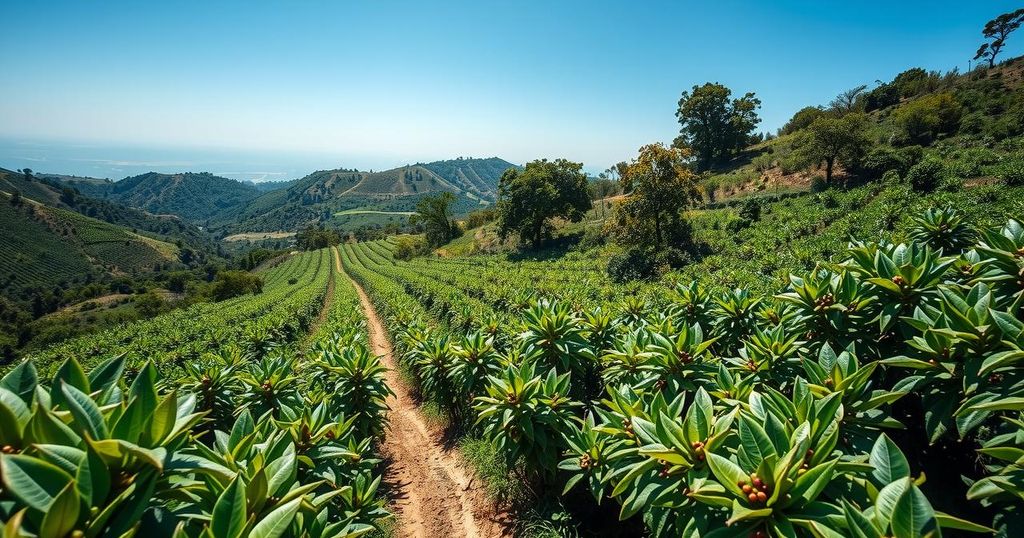Insufficient Rain in Brazil Influences Coffee Prices
On Wednesday, coffee prices saw moderate gains due to dry conditions in Brazil and a strong Brazilian real. Brazilian arabica coffee regions scored low rainfall, prompting concerns over supply. The forecasts suggest a decline in Brazil’s future coffee production, influencing market dynamics as robusta supply also dwindles amidst rising inventory levels.
Coffee prices experienced moderate increases on Wednesday due to insufficient rain in Brazil and the strengthening of the Brazilian real. The May arabica coffee contract rose by 1.89%, while the May robusta coffee contract increased by 1.06%. According to Somar Meteorologia, Brazil’s primary arabica coffee region received only 30.8 mm of rain, which is significantly below the historical average of 71%. Additionally, the Brazilian real reached its highest value against the dollar in four and a half months, which deterred coffee producers from exporting their produce.
Despite rises in robusta coffee prices, growth was constrained by climbing inventory levels. Robust coffee stocks monitored by ICE hit a one-week high of 4,336 lots, while arabica coffee inventories dropped to a three and a half week low of 782,648 bags. Ongoing concerns about supply are anticipated to bolster coffee prices, compounded by a report from Cecafe indicating a 12% decrease in Brazil’s green coffee exports in February compared to the previous year, totaling three million bags.
Forecasts regarding Brazil’s future coffee production present a challenging outlook, as Conab estimates the 2025/26 crop will plummet 4.4% year-on-year to a three-year low of 51.81 million bags. Additionally, the 2024 coffee crop estimate was reduced by 1.1% to 54.2 million bags from a previous estimate of 54.8 million bags. On the downside, Marex Solutions predicts an expanding global coffee surplus by the 2025/26 season to 1.2 million bags, a significant increase from an earlier surplus of 200,000 bags.
Robusta coffee prices are bolstered by decreased production figures in Vietnam. The country, recognized as the leading producer of robusta beans, faced a 20% production drop in the 2023/24 crop year, totaling 1.472 million metric tons, marking the smallest crop in four years. The USDA’s projections for the 2024/25 marketing year anticipate a slight dip in Vietnam’s robusta output to 27.9 million bags from 28 million bags.
The issue of larger global coffee exports also posits a bearish influence on prices, with Conab reporting a record 50.5 million bags of coffee exports from Brazil in 2024, a year-on-year increase of 28.8%. Despite this increase, ICO’s report highlights a 12.4% decline in global coffee exports for December, signaling potential volatility within the market.
The USDA’s December report presented a mixed outlook for coffee prices, projecting a 4% overall increase in global coffee production for 2024/25. It anticipates an increase in both arabica and robusta production, though it also forecasts a 6.6% decrease in ending stocks to a 25-year low. Moreover, there are substantial revisions regarding Brazil’s crop estimates due to prolonged drought conditions, with Volcafe projecting a significant deficit in arabica coffee production for 2025/26.
In conclusion, coffee prices are currently being influenced by a range of factors including insufficient rainfall in Brazil, increased production concerns, and the strength of the Brazilian real. While Brazilian arabica coffee production estimates have been downgraded, robusta prices are experiencing upward pressure due to reduced outputs. Predictions of a widening global coffee surplus and fluctuating export figures underscore a complex market dynamic that could impact future coffee pricing.
Original Source: www.nasdaq.com




Post Comment